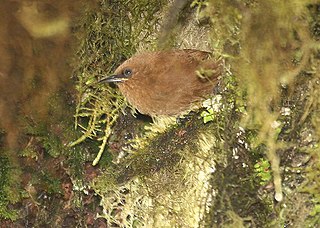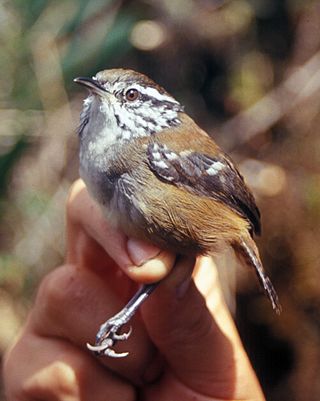
Wrens are a family of brown passerine birds in the predominantly New World family Troglodytidae. The family includes 88 species divided into 19 genera. Only the Eurasian wren occurs in the Old World, where, in Anglophone regions, it is commonly known simply as the "wren", as it is the originator of the name. The name wren has been applied to other, unrelated birds, particularly the New Zealand wrens (Acanthisittidae) and the Australian wrens (Maluridae).

The rufous-breasted wren is a small songbird of the family Troglodytidae. It is found in Colombia, Costa Rica, Panama, Trinidad and Tobago, and Venezuela.

The musician wren or organ wren is a species of wren named for its elaborate song. It is native to the Amazon rainforest in South America, from the lowlands into the foothills of the Andes.

The bamboo foliage-gleaner, also known as the crested foliage-gleaner or dusky-cheeked foliage-gleaner, is a species of bird in the Furnariinae subfamily of the ovenbird family Furnariidae. It is found in Bolivia, Brazil, Colombia, Ecuador, and Peru.

The Peruvian wren is a species of bird in the family Troglodytidae. It is endemic to Peru.

The rufous wren is a species of bird in the family Troglodytidae. It is found in Colombia, Ecuador, Peru, and Venezuela. Its natural habitat is subtropical or tropical moist montane forests.

Apolinar's wren is a passerine bird in the family Troglodytidae. It is endemic to Colombia.

The bar-winged wood wren is a species of bird in the family Troglodytidae. It is found in southern Ecuador and northern Peru.

The ash-colored tapaculo is a species of bird in the family Rhinocryptidae. It is found in Colombia, Ecuador, and Peru.

The grey-mantled wren is a species of bird in the family Troglodytidae. It is found in Bolivia, Colombia, Ecuador, and Peru.

The chusquea tapaculo is a species of bird in the family Rhinocryptidae. It is found in southern Ecuador and far northern Peru.

The rufous spinetail is a species of bird in the Furnariinae subfamily of the ovenbird family Furnariidae. It is found in Colombia, Ecuador, Peru, and Venezuela.

The flammulated treehunter is a species of bird in the Furnariinae subfamily of the ovenbird family Furnariidae. It is found in Colombia, Ecuador, Peru, and Venezuela.

The Inca wren is a species of bird in the family Troglodytidae. It is endemic to Peru.

The moustached wren is a species of bird in the family Troglodytidae. It is found in Bolivia, Brazil, and Peru.

The whiskered wren is a species of bird in the family Troglodytidae. It is found in Colombia, Ecuador, and Venezuela.

The bay wren is a species of bird in the family Troglodytidae. It is native to southern Central America and northwestern South America.

The speckle-breasted wren is a species of bird in the family Troglodytidae. It is found in Colombia, Ecuador, and Peru.

The mountain wren is a species of bird in the family Troglodytidae. It is found in the Andes of northwestern Argentina, Bolivia, Colombia, Ecuador, Peru, and western Venezuela.

Pheugopedius is a genus of wrens in the family Troglodytidae that are found in Central and South America.























